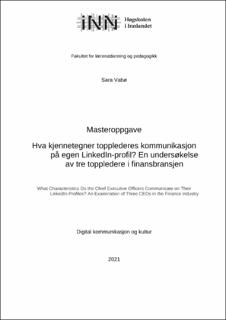| dc.contributor.author | Vabø, Sara | |
| dc.date.accessioned | 2023-01-02T09:35:47Z | |
| dc.date.available | 2023-01-02T09:35:47Z | |
| dc.date.issued | 2021 | |
| dc.identifier.uri | https://hdl.handle.net/11250/3040229 | |
| dc.description | Mastergradsoppgave i digital kommunikasjon og kultur, Høgskolen i Innlandet, 2021. | en_US |
| dc.description.abstract | Norsk:
I denne studien undersøkes det hvordan tre toppledere i finansbransjen kommuniserer på LinkedIn. I en undersøkelse utført av kommunikasjonsbyrået Zynk, beskrives norske lederes aktivitet på sosiale medier som ‘nedslående’, men enkelte ledere beskrives imidlertid som sosiale toppledere (Zynk, 2017, s. 2-4). Zynks undersøkelse vil benyttes for å gjøre rede for hva som kan kjennetegne ‘sosiale’ ledere. Ettersom LinkedIn de senere år har endret karakter og brukerne i større grad enn tidligere produserer innhold (Weiner, 2020), vil det være interessant å undersøke hvordan LinkedIn blir brukt som plattform for kommunikasjon. Med dette som bakgrunn vil tre topplederes tekster og deres aktiviteter på LinkedIn undersøkes med følgende problemstilling: Hva kjennetegner topplederes kommunikasjon på egen LinkedIn-profil? Med kommunikasjon menes det i denne sammenhengen hva topplederne skriver om, hvilke temaer de løfter fram, samt om det er temaer som diskuteres hyppigere enn andre.
Det benyttes en dokumentanalytisk tilnærming til topplederens kommunikasjon. Studien er avgrenset til tre toppledere i finansbransjen: Kjerstin Braathen, Nicolai Tangen og Jan Erik Kjerpeseth. Datamaterialet består av 60 tekster, hvor tekstene plasseres i innholdskategorier for å undersøke om det er gjentakende tematikk, og hvor hyppig ulike temaer kommuniseres. Nettverkets respons på toppledernes tekster vil også bli ivaretatt, da med et blikk på parametere som ‘likerklikk’ og antall kommentarer. Det å ivareta følgernes perspektiv er også i tråd med Gilani et al. og deres studie om sosiale medier-ledere. Deres artikkel blir benyttet som teoretisk rammeverk for å kunne begrepsfeste ulike sosiale medierledere og ‘følgeradferd’ (Gilani et al., 2019, s. 349). Kvantitative metoder er i denne oppgaven ment som et supplement til den bærende kvalitative dokumentanalysen.
I denne studien blir det tydelig at to av topplederne har klare interessefelt i sine tekster, hvor det finnes gjentakende temaer de skriver om. Hos disse topplederne er vektingen mellom å skrive om eget selskap, dets mål og ambisjoner nærmest identisk, hvor resterende tekster er tilknyttet deres egne interessefelt. Den ene topplederen har valgt en annen strategi og kommuniserer nært til egen arbeidsgiver uten egne interessefelt. På samme tid kommuniserer denne topplederen personlig og nært, og setter tekstene i en samfunnsorientert kontekst, noe de andre topplederne ikke alltid evner i sine tekster. | en_US |
| dc.description.abstract | English:
This study explores how tree Chief Executive Officers in the finance industry communicate through LinkedIn. Norwegian leaders’ activity on social media is described as ‘disappointing’ by a communication agency called Zynk (Zynk, 2017, s. 2-4). This agency’s report is used to describe characteristics of ‘social’ leaders. Since LinkedIn has changed over the past few years, and users are now choosing to share more content on the platform (Weiner, 2020), it is relevant to examine how it’s being used as a platform for communication. This thesis will explore the three Chief Executive Officers activity on the platform with the following question: What characteristics do the Chief Executive Officers communicate on their own LinkedIn-profiles? In this context, communication is examining what kinds of subjects they choose to write about, and are there subjects they choose to discuss more frequently than others?
Document analysis is the primary methodical approach used in this thesis. The study is limited to three CEOs in the finance industry: Kjerstin Braathen, Nicolai Tangen and Jan Erik Kjerpeseth. The data material consists of 60 texts which are placed in different content categories to examine if there are any recurring themes and topics, and how often these themes are communicated by the CEOs. The LinkedIn networks response to the texts are examined by looking at parameters as ‘likes,’ and how many comments they received on each text. Quantitative methods are used as a secondary approach to the primary qualitative analysis which is represented by the document analysis. By measuring the followers response, we get their perspective, and this corresponds well with Gilani et al. and their study related to social media leaders. Their article is used as a theoretical framework to establish what it means to be a social media leader, how there are different categories of social media leaders and how followers react to content on social media. (Gilani et al., 2019, s. 349).
In this thesis it becomes obvious that two of the CEOs have clear interests in their texts, which have recurring themes and topics that they write about. Among these two leaders, they balance their overall business goals with their own interests, and their balances are very similar. The other CEO chose another strategy that communicates very closely to their business objectives. At the same time, this particular CEO communicates in a personal way and has an overall perspective on society. This perspective on society is often missing in the other CEOs texts. | en_US |
| dc.language.iso | nob | en_US |
| dc.subject | DIGKOM | en_US |
| dc.subject | kommunikasjon | en_US |
| dc.title | Hva kjennetegner topplederes kommunikasjon på egen LinkedIn-profil? En undersøkelse av tre toppledere i finansbransjen | en_US |
| dc.title.alternative | What Characteristics Do the Chief Executive Officers Communicate on Their LinkedIn Profiles? An Examination of Three CEOs in the Finance Industry | en_US |
| dc.type | Master thesis | en_US |
| dc.source.pagenumber | 160 | en_US |
